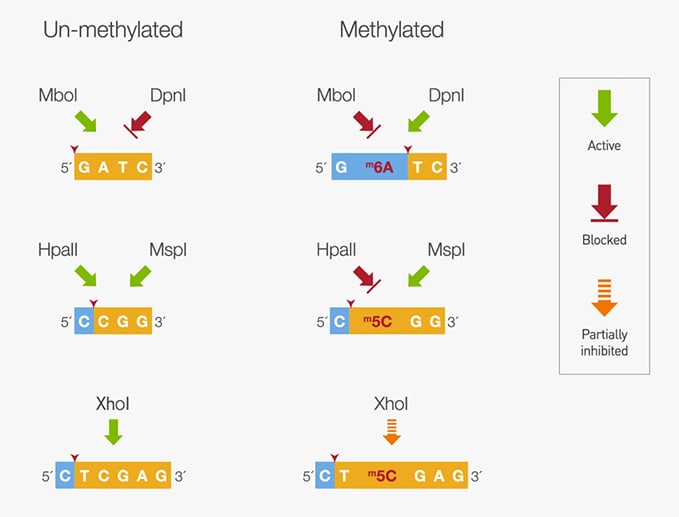what is the substrate of a restriction endonuclease?
A restriction enzyme restriction endonuclease or restrictase is an enzyme that cleaves DNA into fragments at or near specific recognition sites within molecules known as restriction sites. In these cases no major changes were observed in the cleavage characteristics of the enzyme.

Enzyme Learning Activities For Ap Biology Distance Learning Biology Common Core State Standards Distance Learning
Only the 3 to 5 strand is shown.

. Once methylated the host DNA is no longer a substrate for the endonuclease. Each restriction endonuclease is a unique enzyme with individ-ual characteristics which are usually listed in suppliers catalogs. Proteins 7 185 197 1990. The restriction endonuclease RflFI could be separated from cell extracts by phosphocellulose and heparin-sepharose chromatography.
Restriction endonucleases also known as restriction enzymes identify DNA at restriction sites or recognition sequences to cleave DNA into smaller fragments. Restriction enzymes can be isolated from bacterial cells and used in the laboratory to manipulate fragments of DNA such as those that contain genes. The key difference between restriction endonuclease and exonuclease is that restriction endonuclease is a nuclease enzyme that recognizes a specific DNA sequence and cleaves the DNA within or adjacent to that sequence while exonuclease is a nuclease enzyme that cleaves the nucleotides in a polynucleotide from either 5 end or 3 end one at a time. 3-ATATGC-5 3-ATCGTG-5 O 3-GCGCGC-5 3-ATCGAT-5 O3-ATCCTA-5.
Phosphodiester bond cleavage occurs at a DNA. A vial of 6X Purple Load Dye is included with most restriction enzymes. Restriction endonucleases are enzymes that recognize a specific DNA sequence called a restriction site and cleave the DNA within or adjacent to that site. The substrate specificity of the EcoRI restriction endonuclease can be varied in vitro by changing the pH and the ionic environment of the reaction.
Restriction enzyme also called restriction endonuclease a protein produced by bacteria that cleaves DNA at specific sites along the moleculeIn the bacterial cell restriction enzymes cleave foreign DNA thus eliminating infecting organisms. The restriction endonuclease and modification methylase genes lie adjacent to each other on the host chromosomal or plasmid DNA and may be oriented transcriptionally in. Which of the strands could be a substrate for a restriction endonuclease. After a 60-minutes incubation at the appropriate temperature the digestion is stopped and the DNA samples are visualized by agarose gelethidium bromide electrophoresis.
The rate constants k 2 and k 3 describe the phosphodiester hydrolysis and product release respectively. The asterisk indicates an additional low-level endonuclease cleavage site at nucleotide 16 of G20. Where E denotes the restriction endonuclease EcoRV and P 1 stands for the product that contains the loop portion and half of the original stem and P 2 the product that has the fluorophore and the quencher bound to it. Over 210 restriction enzymes are 100 active in a single buffer CutSmart Buffer.
Restriction enzymes are nucleases - enzymes that cut nucleic acid polymers ie. Choose from 280 restriction enzymes the largest selection. For example the restriction endonuclease EcoR I isolated from the bacterium Escherichia coli recognizes the following sequence. Restriction enzymes are commonly classified into five types which differ in their structure and whether they cut their DNA.
A restriction endonuclease typically requires a recognition site and a cleavage pattern typically of nucleotide bases. The positions of RNA substrate G20 and products of endonuclease G11 and transcription initiation G11 1nt are indicated on the left. Restriction enzyme digests utilizing RflFI alone or in combination with SalI a restriction enzyme isolated from Streptomyces albus G showed that the DNA sequence recognized by RflFI either overlapped or was the. 190 restriction enzymes are Time-Saver qualified meaning you can digest DNA in 5-15 minutes or digest DNA safely overnight.
Substrate recognition by the Eco RI endonuclease. An example is the directed evolution of RBstYI endonuclease 5-RGATCY-3 that resulted in genetic selection of two RBstYI variants with increased substrate specificity toward 5-AGATCT-3 and discrimination against 5-GGATCC-3. If the recognition site is outside the region of the cleavage pattern then the restriction endonuclease is referred to as Type I. CAS Article Google Scholar.
Reaction 1 is schematically represented in Scheme 1. Endonucleases make cuts within a DNA polymer. Restriction enzymes are one class of the broader endonuclease group of enzymes. Restriction enzymes are a type of endonuclease - they cut at specific sites in the middle of DNA strands.
Restriction endonuclease activity assays are performed by adding different enzyme dilutions to the appropriate assay buffer containing 1 µg of substrate DNA. Exonucleases remove individual nucleotides from the end of a strand. The rate of cleavage at each site within a given DNA substrate can vary Thomas and Davis1975Fragments containing a subset. Hemi-methylated DNA such as after a fresh round of replication is also protected from digestion.
A C G T. Whereas the substrate of the restriction enzyme is foreign DNA which is cleaved in response to defined recognition sites that of the modification enzyme is the DNA of the host which is modified at the recognition sequence and thereby protected against attack by. Restriction endonucleases come in several types.

Restriction Enzymes In Genetic Engineering Biotechnology Genetic Engineering Biology Class

Restriction Enzyme Key Considerations Thermo Fisher Scientific Ng

Major Differences Com Molecular Biology Biology Notes Biotechnology Lessons

Enzyme Temperature Sensitivity Enzymes Biology Class Biochemistry

Covalently Closed Circular And Linearized Plasmid Substrates 2686 Bp Download Scientific Diagram

Solid Substrate Fermentation Ssf Biology Class Fermentation Life Science

Plasmid Substrates A Puc19 Contains Two Sites For Bgli Marked A And Download Scientific Diagram

Pin By Jack Mankin On Biology Biochemistry Competitive Inhibition Enzyme Kinetics
Posting Komentar untuk "what is the substrate of a restriction endonuclease?"